
This site celebrates the life and work of sculptor
John Cassidy (1860 - 1939).
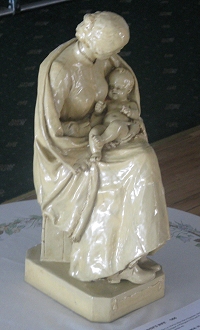
Its story seems to begin with a version, described as bronze, which was shown by Cassidy at the Manchester Art Gallery's Autumn 1906 exhibition, again at his Lincoln Grove studio exhibition of 1914/15.
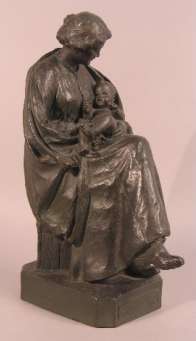
The version shown above, described as 'a bronzed group "The Weavers Wife", signed and dated 1906, 15 ¾" high' surfaced on 12 September 2008 in an auction held by Dee Atkinson & Harrison in
the Exchange Saleroom, Driffield, East Yorkshire, and was sold for £180. Note that it is 'bronzed' suggesting it is cast in some other material and then treated to resemble bronze.
A Cassidy bronze titled 'Bonny Brid' [1923.04], was exhibited at the Manchester Academy exhibition 1923, lent by T.Greg Dowson. In the light of the Samuel Laycock connection (see below) it must surely be the bronze from the 1906 exhibition under another title.

This picture links to a larger detail.
Samuel Laycock
The first verse of the poem 'Welcome, Bonny Brid!' (see full text in adjacent column) by dialect poet Samuel Laycock (1825–93) of Stalybridge was displayed with 'The Weaver's wife' when exhibited at the Manchester Art Gallery. It tells of a baby born in 1863 during the 'Cotton Famine' when the American Civil War prevented raw cotton from arriving at the Lancashire cotton mills, creating unemployment and great hardship. Laycock himself lost his income at this time.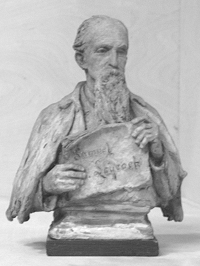
Samuel Laycock, weaver, poet, librarian and photographer, is the subject of a small clay half-figure, pictured above, by Cassidy, dated 1935 [1935.01] and currently in storage at Manchester Art Gallery. His first job, aged 9, was in a woollen mill in his birth place Marsden, and from the age of 11 he worked in a cotton weaver before becoming librarian of the Mechanics Institute of Stalybridge (then in Cheshire) in 1862. He moved to Blackpool in 1867.
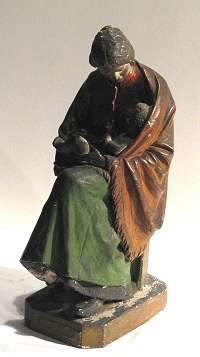
Thanks
Our thanks are due to Peter Ogilvie and Carrie May of Salford Museum and Art Gallery who kindly allowed us special access to the 'Weaver's Wife' in their storage area and allowed us to take and publish the pictures shown here. The museum, and the Salford Local History Library, are located close to Salford Crescent railway station, and a visit, especially to their Victorian Gallery and Pilkington Pottery exhibit, is recommended, even though this work is not on display.(2019: The Local History Library currently can only be visited by appointment.)
Links and References
Pilkington's Lancastrian Pottery Society
Salford Museum and Art Gallery
Peter Scott Gallery, University of Lancaster
War memorial lych gate, St Peter's Church, Swinton
Samuel Laycock: The Collected Writings of Samuel Laycock, second edition, issued 1908.
The Weaver's Wife (1906)
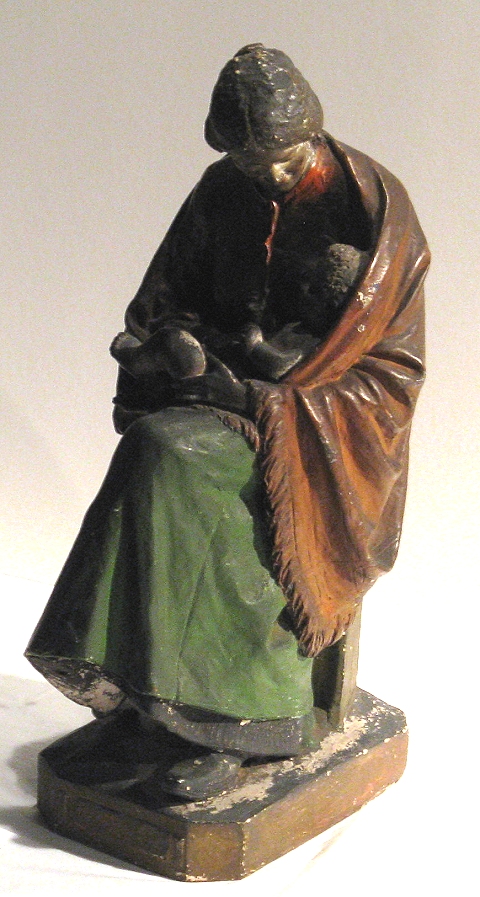
Catalogue number 1906.01
This painted plaster 'Weaver's Wife', which has lost one clog-ed foot at some time, is in the collection of Salford Museum and Art Gallery, although not currently on display. Cassidy incorporated a great deal of observed detail into the work, including a patch sewn on the knee of the skirt. Previously it was part of the collection of Monks Hall Museum in Eccles (since 1975 part of the Borough of Salford). A glimpse of its story can be found in the Eccles local newspaper, The Journal, of 19 May 1976:
| Gives treasure to
museum A small Edwardian statue has been given to Monks Hall museum in Eccles by a Swinton pensioner who has tresaured the sculpture for years. Amateur historian Mr John Tabbron, aged 68, of Byron Avenue, came across the piece, "The Weaving Wife," when he worked at Pilkington's Tiles Ltd, Clifton Junction. He has kept it in his home ever since. The 15-inch high statue was fired at Pilkington's by a sculptor called John Cassidy, a well-known artist of his time, who also carved the figures on the lych gate at St Peter's Parish Church in Swinton. The Edwardian artist also made the big bronze statue called "The Drift" [i.e.'Adrift'] now in Manchester's Piccadilly Gardens. The "Weaver's Wife" depicts a young woman in calf-length dress seated with her baby in her arms and is painted in somble browns, greens and black. Mr Michael Lever, Keeper of Arts at Monk's Hall, said: "It is certainly of interest to us from the point of view that we can now link the work of John Cassidy with the carvings at St Peter's Church. "It makes it interesting for Swinton people and we thank people like Mr Tabbron tremendously for we have a limited budget and rely on donations by members of the public," he said. |
Monks Hall is a large house on Wellington Road in Eccles described on the British Listed buildings website as ' c.1840 with later additions but incorporating a seventeenth-century timber-framed structure.' Built on the site of a grange built by monks of Whalley Abbey, it came into the ownership of Eccles council was and opened as a museum in 1962. Eccles became part of the new Borough of Salford in 1974 and the building was later closed and sold, its exhibits being moved to the Salford Museum and Art Gallery. From about 1997 to 2003 it was used as a restaurant, after which the building stood empty, suffering vandalism. In 2009 a developer applied for planning permission to turn it into four apartments and build others in the grounds, but no work was ever started. Sadly, but predictably, it became a target for arsonists, and became a derelict shell.
William Burton (1863-1941) Manager of the Pilkington works, is known to have commissioned designs from respected artists of his day, including Lewis Foreman Day, Walter Crane and John Cassidy. The work which Mr Tabbron 'came across' may have been a test for a possible production run of copies in pottery of Cassidy's piece. There is another plaster copy in the Pilkington Pottery collection of the Peter Scott Gallery, University of Lancaster. Also known is a Pilkington's 'lustreware' vase bearing the legend John Cassidy 1907' which appeared in Sotheby's auction in Sussex on 23 June 1999 and sold for £368. This was perhaps created by the Pilkington potters as a tribute to Cassidy and his work for them, or maybe came about through Cassidy's connections with the Northern Art Workers' Guild. Any information about this vase, and indeed anything at all about Cassidy's work with Pilkington's, would be very welcome.
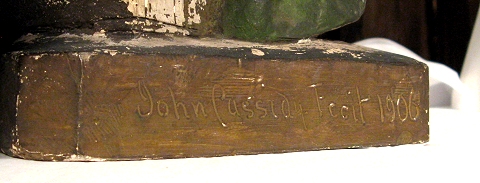
Above, the signature on 'The Weaver's Wife': John Cassidy Fecit 1906. The title is on the front of the base.
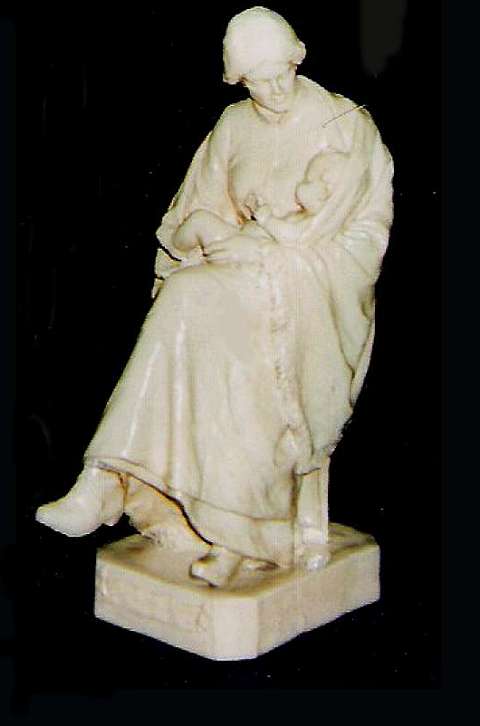
This oatmeal-glazed ceramic example of the work was definitely produced at Pilkington's Royal Lancastrian Pottery, Clifton Junction, and may be one of an edition, or possibly itself is a test piece. It came to Lis Nicolson from her grandmother Marion Marjorie Pearson (later Tyldesley) who was a friend of Gwladys Rogers, a painter of pots for Pilkington's, particularly well-known for decorating the new lapis ware pottery in the late 1920s. Marion Marjorie Pearson, born in Salford in 1886, daughter of Joseph Pearson, a joiner and cabinet-maker, studied at Hereford Teacher Training College from 1904-1906, where a fellow-student was Elsie Radford, daughter of the famous potter Edward Thomas Radford, who threw many pots for the Pilkington company, making another possible family connection.
In 1953 the Clifton factory ceased to make pottery items of this kind, concentrating on their famous and successful range of ceramic tiles. Sadly, however, the Pilkington Group called in the administrators in summer 2010, and the Clifton factory closed.
From 'Miscellany', Manchester Guardian, 21 September 1906, p. 3
According to the catalogue Mr. Cassidy's bronze in the Autumn Exhibition, "The Weaver's Wife", is indended to illustrate Samuel Laycock's lines:
Tha ’rt welcome, little bonny brid,
But should n’t ha’ come just when tha did;
Toimes are bad.
We ’re short o’ pobbies for eawr Joe,
But that, of course, tha did n’t know,
Did ta, lad?
In Laycock's published poems, however, the lines are spoken not by the mother but by the father of the "bonny brid", and an illustration shows the father nursing the little one, while the last verse reads:
But though we ’n childer two or three,
We ’ll make’ a bit o’ reawm for thee—
Bless thee, lad!
Tha ’rt th’ prattiest brid we han i’ th’ nest;
Come, hutch up closer to mi breast—
Aw ’m thi dad.
The poet's son-in-law, Mr. Sim Schofield, tells a curious story about the poem, as related to him by the author. It was written during the trying times of the cotton famine, and at the time the baby was being born Laycock sat down in a corner of his humble dwelling and wrote these verses; he said he never wrote a poem in so short a time, and that then, if ever, he was under the spell of inspiration. The poem was meant for a son, and when told the the newcomer was a daughter he made it known that he had made a poetic welcome for a 'lad' and no-one, he said, would persuade him to alter it. And so the 'bonny lad' that was to be turned out to be a 'bonny lass' - now Mrs Sim Schofield, of Manchester.
Welcome, Bonny Brid!
by Samuel Laycock| Tha
’rt welcome, little bonny brid, But should n’t ha’ come just when tha did; Toimes are bad. We ’re short o’ pobbies for eawr Joe, But that, of course, tha did n’t know, Did ta, lad? Aw ’ve often yeard mi feyther tell, ’At when aw coom i’ th’ world misel Trade wur slack; An’ neaw it ’s hard wark pooin’ throo— But aw munno fear thee; iv aw do Tha ’ll go back. Cheer up! these toimes ’ull awter soon; Aw ’m beawn to beigh another spoon— One for thee; An’ as tha ’s sich a pratty face, Aw ’ll let thee have eawr Charley’s place On mi knee. God bless thee, love, aw ’m fain tha ’rt come, Just try an’ mak thisel awhoam: What ar ’t co’d? Tha ’rt loike thi mother to a tee, But tha ’s thi feyther’s nose, aw see, Well, aw ’m blow’d! Come, come, tha need n’t look so shy, Aw am no’ blackin’ thee, not I; Settle deawn, An’ tak this haup’ney for thisel’, There ’s lots o’ sugar-sticks to sell Deawn i’ th’ teawn. Aw know when furst aw coom to th’ leet Aw ’re fond o’ owt ’at tasted sweet; Tha ’ll be th’ same. But come, tha ’s never towd thi dad What he ’s to co thi yet, mi lad— What ’s thi name? |
Hush! hush!
tha munno cry this way, But get this sope o’ cinder tay While it ’s warm; Mi mother us’d to give it me, When aw wur sich a lad as thee, In her arm. Hush a babby, hush a bee— Oh, what a temper! dear a-me, Heaw tha skroikes! Here ’s a bit o’ sugar, sithee; Howd thi noise, an’ then aw ’ll gie thee Owt tha loikes. We ’n nobbut getten coarsish fare, But eawt o’ this tha ’st ha’ thi share, Never fear. Aw hope tha ’ll never want a meel, But allus fill thi bally weel While tha ’rt here. Thi feyther ’s noan bin wed so long, An’ yet tha sees he ’s middlin’ throng Wi’ yo’ o: Besides thi little brother, Ted, We ’n one up-steers, asleep i’ bed Wi’ eawr Joe. But though we ’n childer two or three, We ’ll make’ a bit o’ reawm for thee— Bless thee, lad! Tha ’rt th’ prattiest brid we han i’ th’ nest; Come, hutch up closer to mi breast— Aw ’m thi dad. |
Page created by Charlie Hulme and Lis Nicolson. November 2010. Updated January 2019